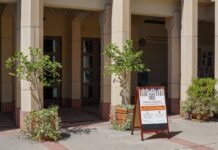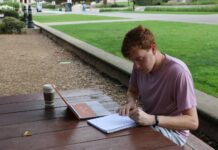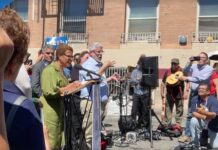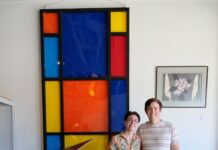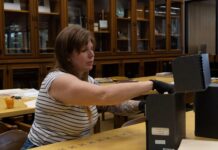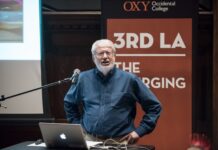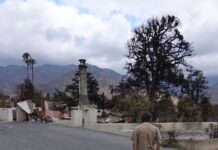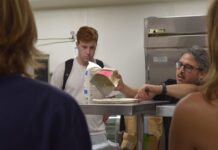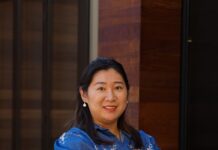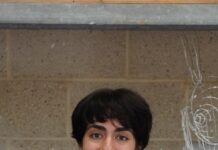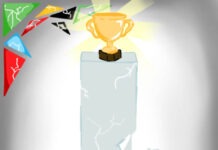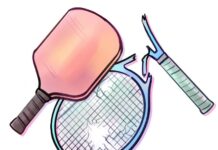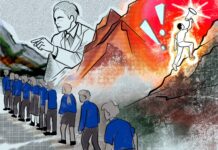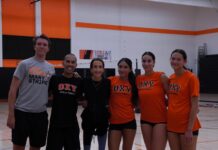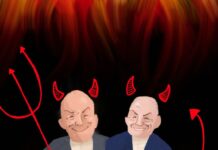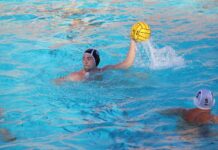Author: Emma Lodes
In a hiccup of sand, a pickup truck screeches to a stop in a Pasadena alleyway. Ten college students jump out of the truck bed and begin shoveling one cubic yard of sand onto the sidewalk. Twenty minutes later the truck bed is empty, and students immediately start shoveling the sand back into the truck bed. Leaving traces of dust on the pavement at each spot, they continue this routine in a sweeping arc across Los Angeles. By the time the students return to campus, the load is reduced to a mere residue of fine gravel.
Unloading and reloading sand across Los Angeles may not look like fine art at first glance, but for Occidental’s “Advanced Projects in Interdisciplinary Arts” class, the strange, seemingly pointless chore is a work of art. The project, a recreation of conceptual artist Allan Kaprow’s “Labor Day,” was a class project two years ago. Photos documenting the day ended up in the Little Tokyo’s Museum of Contemporary Art in 2008. This year’s students in “Advanced Projects” continue to push the boundaries of the traditional definition of art.
Studio Art professor Mary Beth Heffernan teaches the class only once every two years. Students in “Advanced Projects” take off on desert field trips, participate in carefully planned flash mobs on campus, pitch proposals to have their installations approved by administrators and let their creativity run wild.
Two of the course’s major assignments are an informal class project and a “Relational Aesthetics” project. For their informal class project, students found a “desire path” – an impromptu short-cut that becomes well-worn throughout time by groups of people – and decorated it with rose petals. The students picked the popular short cut from the Academic Quad fountain to Branca Patio. The project is an aesthetic way to underscore the intuitive social movement of groups creating their own pathways.
“The plan behind this was to give a simple poetic gesture that gets people to think about their unconscious movements and actions through space,” Heffernan said. “It’s also a way to garner a kind of ideality or to confer a kind of beauty on a spot that’s been degraded.”
Heffernan calls “Relational Aesthetics” a social art or the spirit of conviviality. For their Relational Aesthetics project, students channel the idea of art as a verb by creating projects that prompt human interaction or connection.
A few weeks ago, it rained on campus – the perfect conditions for a peculiar experiment in Relational Aesthetics. Throughout the day, if anyone walked into the Quad, a team of fellow students holding umbrellas convened and walked them through the quad. The umbrella-holders did not speak. Some students reacted with gratitude, some were uncomfortable and others became hostile.
Art History and Visual Arts (AHVA) major Daisy Cortes (senior) and visual arts major Hannah Rindlaub (junior) are enrolled in the class and enjoy the creative flexibility required for Relational Aesthetics.
“It opens up a new world for people to exist in,” Cortes said.
Rindlaub elaborated on some of the projects students have undertaken.
“Someone’s project was they held this meal where everyone had to feed each other, and no one could feed themselves,” Rindlaub said. “That’s part of the fun we have. Just not looking at art in a typical way.”
Cortes, Rindlaub and the rest of the class are currently working on their major installations that will be constructed on campus. Cortes will be scattering books around campus that contain prompts and questions to be answered by the public and blank pages on which people write their own prompts.
“My goal is to create physical social networks for people to interact with each other and create connections,” Cortes said.
Rindlaub will be building a nomadic home and propping it in the middle of the quad.
“It’s going to be a tent structure, and there’s going to be a crazy awesome dance playlist going on, and you’re supposed to go in and dance for yourself,” Rindlaub said. “The idea is that your skin is your real nomadic home, and dancing for yourself is the most comfortable you can be. It’s about notions of home and how that can be a mindset.”
These projects involve more than walking into the Quad with some materials and starting to build a tent. Creating installations requires foresight and planning. Depending on the location of their installations, students must confer with Bruce Steele of Facilities Management, Campus Safety, Facilities and the Academic Commons staff, among others.
“We have to pitch proposals for our pieces and learn to jump through bureaucratic hoops,” Cortes said. “That’s a skill I never had before.”
The class also escapes off campus. This semester they’ve visited Anza Borego National Park and “Salvation Mountain” in Slab City. Depicted in the film “Into the Wild” (2007), Salvation Mountain is a massive, colorful art installation on a hill near the Salton Sea made of adobe and straw and covered in Bible verses.
Out in the middle of the desert, the students reinstalled their Relational Aesthetics projects.
“The idea was to make an ‘Oxy environment’ version and a ‘desert environment’ version to see how the meaning of the work changed in different contexts and to show the importance of site and location that influences the meaning of a work,” Heffernan said.
The fieldtrip was funded by L.A. Encounters with Curriculum, a fund that encourages classes to engage with the Los Angeles community.
From field trips to installations to interactive projects, several students agreed that the essence of the class’ spirit was the concept of “unscripted play,” an idea that Heffernan endorses in all kinds of art. Unscripted play involves letting oneself explore uncensored and allowing oneself to make spontaneous discoveries through unexpected results and accidents.
“It brings you back to having fun like a kid,” Rindlaub said. “We’re like kids running around playing, and she’s supporting our creativity. She has to rein us in sometimes.”
This article has been archived, for more requests please contact us via the support system.
![]()


